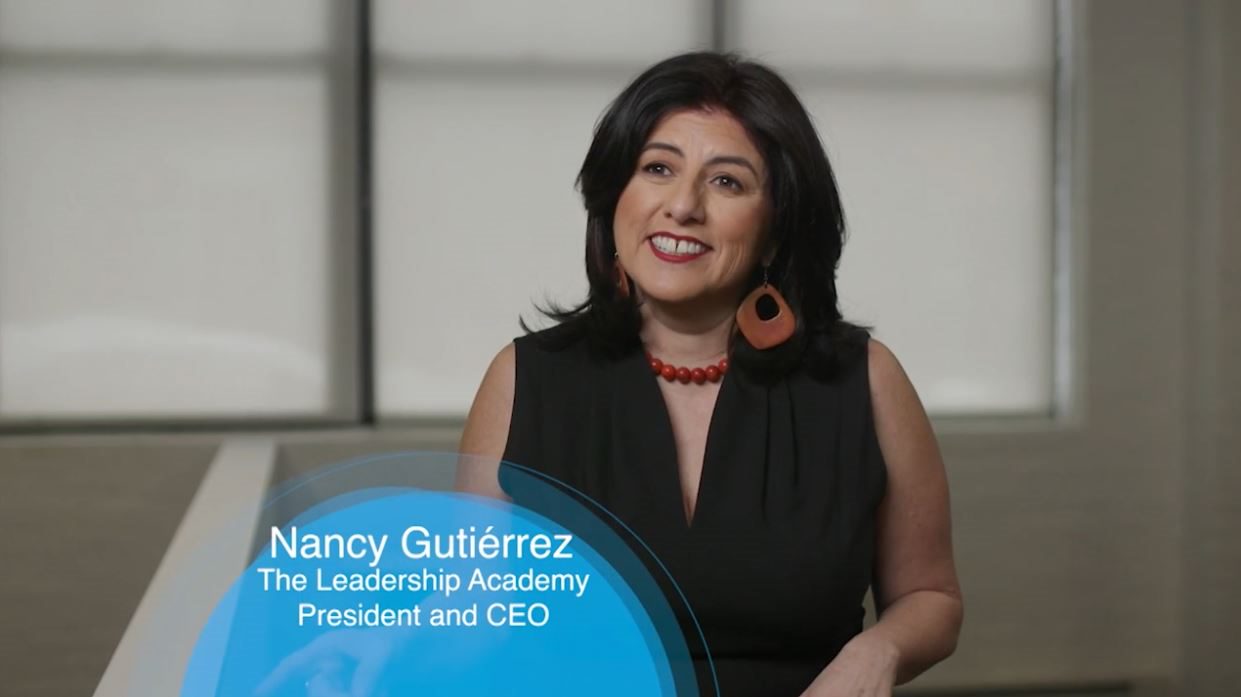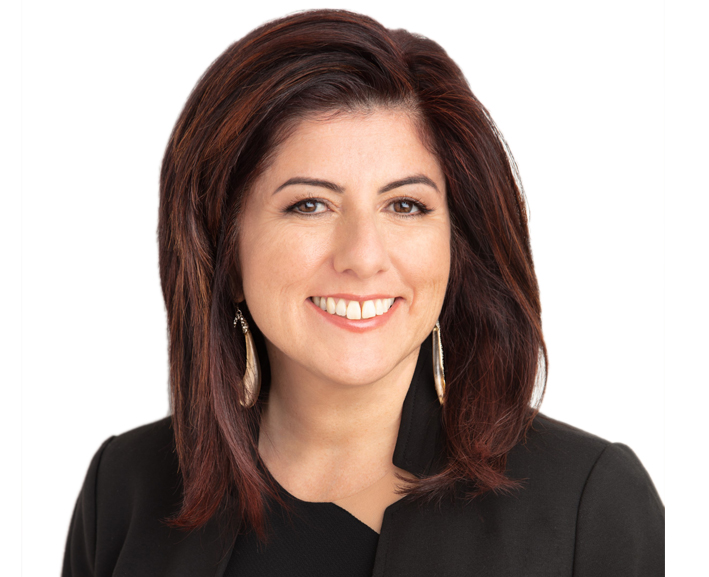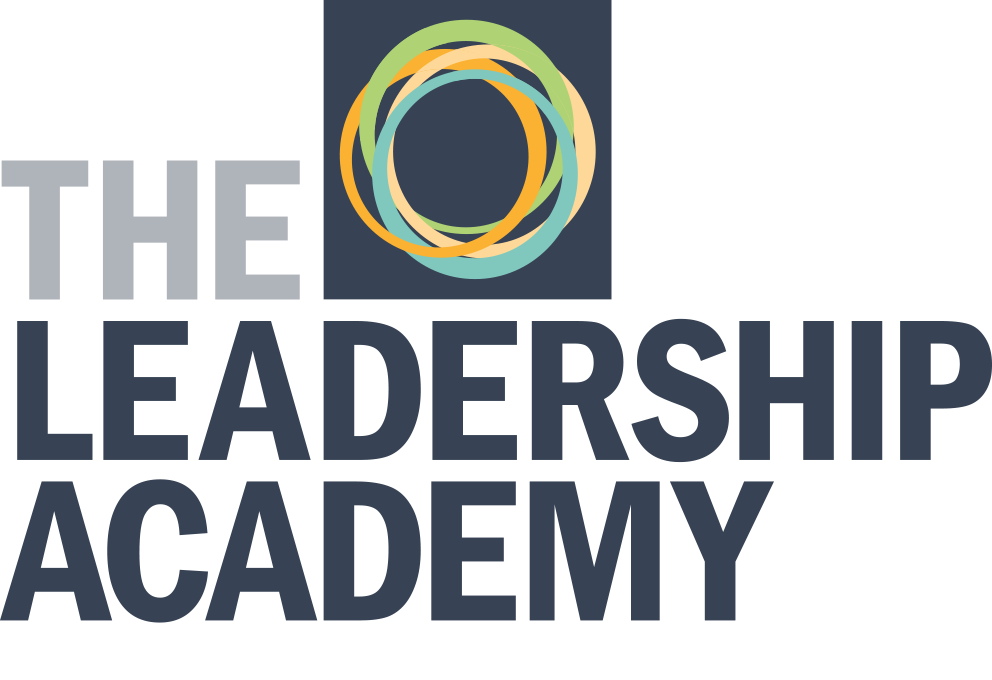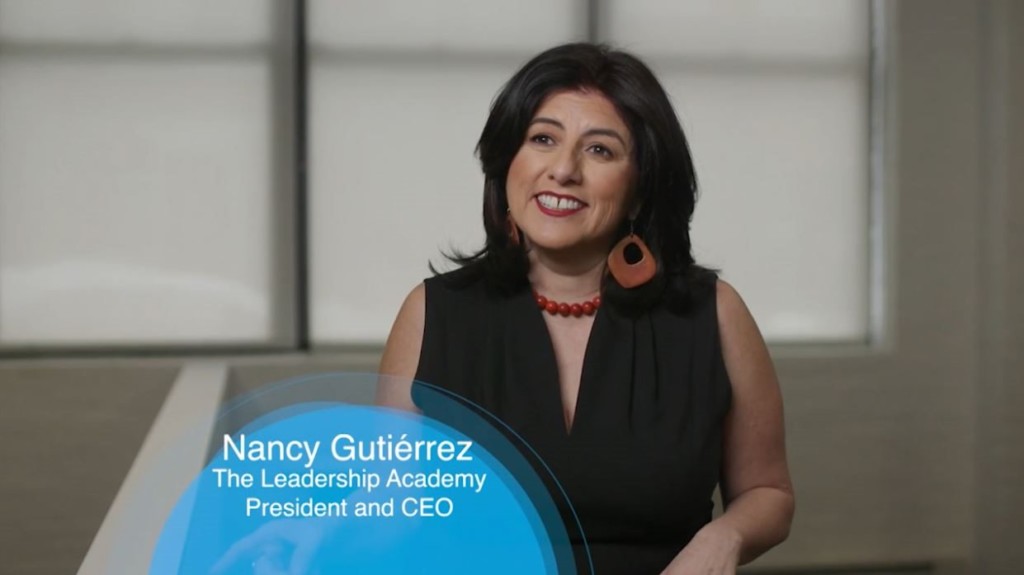Featured Blog Post: Dr. Nancy B Gutierrez


My 8th grade English teacher saved my life.
That is not an overstatement, it is simply a fact. Had Mr. Lovelace not lead his classroom in ways that acknowledged my identity as one of six kids from a beautiful Mexican family going through a divorce and struggling to make ends meet, had he not helped me feel connected to literature and to think critically about, well, everything, I’m not sure where I would be today.
Mr. Lovelace did for me and my classmates what we at The Leadership Academy encourage leaders to do every day: to lead in ways that are culturally responsive, to create spaces for learning that make young people feel seen, respected, affirmed, and provide opportunities to both grapple with difference and build bridges with others. It is in those environments, science tells us, that our brains are best able to process and retain information, to think critically and creatively and engage actively in learning.
As Professional Standards of Educational Leaders (PSEL) Standard 5 states, a critical piece of being a good school leader is “to cultivate an inclusive, caring, and supportive school community that promotes the academic success and well-being of each student.”
To further illustrate what this work looks like in practice, I recently sat down with three exceptional school leaders in my home community of East San Jose, CA, to hear their leadership stories. It was in that beautiful community that I had that life-changing experience as a middle school student; it is where I grew as a teacher and later as a principal, always inspired by Mr. Lovelace and with the opportunity to work with amazing school principals. Today, East San Jose’s Alum Rock School District is a beautifully diverse community, where 98% identify as students of color–majority Latinx, and 81% receive free or reduced priced meals.
I’m honored to introduce you to three school principals: Vince Iwasaki of Renaissance Academy at Mathson, Tracy Leathers of Ocala STEAM Academy, and Viviana Cabrales Garcia of Dorsa Elementary School. These culturally responsive leaders and their teams are exemplifying PSEL Standard 5 by creating caring communities for their students, staff, and families. They offer much of what The Leadership Academy outlines in our Portrait of a Culturally Responsive School. As you read their leadership stories, ask yourself, “How am I or leaders I know creating the learning experiences and environment students need to thrive? How can I build my muscle as a culturally responsive leader to give to my students, what I want for my own kids?”
Dr. Nancy B. Gutierrez: An Interview with Leadership
Gutiérrez: “So good to talk with you all. It makes me very proud to engage in this conversation given our time working together in Alum Rock. Principal Iwasaki, you and I co-founded Renaissance Academy together which was monumental for our community. Principal Leathers, you were on the ground level with me in our work to lead a turnaround middle school. Principal Garcia, you coached our school’s leadership team and strategically guided our continuous improvement. Truly, each of you played a key role in my leadership development and I am overjoyed to watch you continue to lead in my home community. Let’s jump in to a conversation about your leadership, beginning with students. Is there a story of a student who exemplifies your work at your school?“

Garcia: “Let me tell you about Alejandro (name is changed). I was so proud that he graduated last year. When he came to us in middle of 2nd grade, he had had a hard time in his old school. He would not do his work, he would put his hood on. It was clear he could not read or write. In 3rd grade, he looped with his teacher. But partway through the year, he stopped coming to school. One of our teachers started going to his house every morning to walk him to school. After a while, the teacher would be walking to his house and Alejandro would already be on his way. Getting him into school was a huge turning point. Then we could focus on his learning needs. He was reading at kindergarten level. We referred him for an evaluation but ran into obstacles because of his poor attendance record. We finally won permission to evaluate and were able to place him in a resource class so he could get the support he deserved. He began to read. His behavior began to change. He was promoted to 6th grade last year. I had a conversation with his middle school principal over the summer to maintain the momentum during the transition, and now that the year has started, we continue to talk to support him together.”
Gutiérrez: “That story is a beautiful way to kick off this conversation, thank you. Clearly you built trust with Alejandro and his family to help get him to where he is. What are additional ways principals build trusting relationships? We are some key leadership moves you’ve leveraged that every principal should consider?”
Garcia: My first year as principal, it was obvious that people in our community had experienced a lot of pain. People were skeptical about me so I made sure to tackle it head on. I consistently made myself available outside at drop-off to hear parents’ concerns; I attended teacher team meetings to listen and learn; and I surveyed students formally and informally. I heard a lot of stories of staff feeling disrespected and belittled, students feeling scared, and families feeling unwelcomed. I then needed to act with intention. While I was not responsible for people’s prior experiences, I was responsible for repairing the damage caused by those prior experiences. I acted with transparency, which has been an important part of my leadership. I shared the data I collected so that everyone could understand why I was moving forward with certain decisions. When I have data, I never sugar coat it. Even if the data points a finger at me, I still share it.
Gutiérrez: How do you make students feel like they belong in your school?
Iwasaki: We make sure all the staff – office staff, partner organizations, after-school groups – understand that kids may come with a variety of difficulties, but we think of each of them as our own. Our advisory cohort is so important for this. Each student’s advisory teacher is their primary touchstone. If a child is struggling in math, the advisory teacher can advocate for that student. The advisory also gives students the chance to build community among themselves, as they stay together as a cohort for all their classes. They develop an affection for one another, and teachers cultivate that affection.
Gutiérrez: What about extending that sense of belonging to your families?
Leathers: We engage in one-on-one conversations with every single family every year. Before Covid, we made home visits. It was a chance for families to get to know us and not see us as scary people. We would proactively share information about our counseling programs to support social and emotional learning. We wanted our families to trust our intentions and to understand the wonderful opportunities we offer – group therapy, individual counseling – rather than waiting for something to go wrong before we made contact. We want them to see us as true partners.
Iwasaki: A lot of our families have not navigated the American education system well so it can be hard and confusing for them. The advisory teacher is the primary link to all things school related, a one-stop shop advocate who will support them and the needs of their child. Teachers make contact with parents on a regular basis. They go out of their way to accommodate family schedules, meeting them at 7 in the morning or in the evening. It shows families that we care about them. Some students will try to live in the space between us and their family and our goal is to make sure there is no space there.
Garcia: Families know me. They know they can come to me. During Covid, my focus was on keeping them informed with weekly posts they could count on. I respond to them as soon as I can, make them feel like they know that if they bring something to me, I will follow through. I work in service of our families.
Gutiérrez: PSEL Standard 5 reminds us that creating a caring and supportive school community is important for students to be able to focus on their learning. How do you make students feel safe at school?
Garcia: We have a clear system for addressing different behavior. When a student comes to me, I ask myself, “What do I know about this student, about their family?” I check data about the student. I rarely if ever go to punitive consequences right away. I look at the skills that child is struggling with. Then we create a plan focused on those skills. One student a few years ago often just blew up toward the end of the day. We worked with him and his parent to create a safety plan, which included spending a day with me, watching videos on breathing, and supporting office staff. Our counselor helped him recognize when he was approaching the point of exploding, and he and his teachers came up with a signal so he could let them know when he was feeling upset. I told him, “When you reach that point, give the signal and you can come to my office, you can sit and talk with me, not talk, walk with me.” We’re always trying to provide students with a safe option.
Iwasaki: We talk with kids a lot about wanting everyone to be safe and comfortable here. My first year as principal, we had 165 suspensions for 350 kids. It took me a year and a half, but we started running restorative practice and trauma informed practice. As teachers were disciplining kids, I was explaining to them that there are reasons this kid got upset, and nine times out of 10 it’s not personal, it’s a response to trauma – in one instance, a kid’s brother was released from prison the night before, got drunk, and came home and wreaked havoc. But the teacher didn’t know that. You need to listen when a child is talking with you. We use de-escalation techniques like taking the student for a walk or giving them space to settle down before trying to resolve the issue. We counsel with a lens toward what is getting in the way of kids being successful. If it’s mental health and safety issues, we address those first. We do have some physical safety issues, like traveling to school and bullying because we’re located in a heavily gang influenced area. We make sure we follow up and look at how kids are interacting with one another. We have to clean all that up, otherwise kids don’t feel safe here and they will move back to not trusting us. It’s Maslow – you need safety and security covered or you won’t be able to do the learning. My staff are willing to stick with a kid through difficulty, to listen and take seriously what they are saying, and that makes a big difference for them. By my fourth year, we were down to 12 suspensions a year and continue to implement restorative practices on a consistent basis. We had the highest levels of growth on standardized tests in the district by our 4th year. Kids felt safer on campus. Growth happened because classrooms felt calmer, and when classrooms are calmer, more learning happens.

Gutiérrez: We have all seen that when students have agency over their learning, they are more engaged and their academic success soars. How does your school give students ownership over their learning?
Leathers: The year I became principal, we adopted a project-based learning model. It has been a game changer for integrating student voice into what we were learning. Students are doing things that they love. Take our current 8th grade project, Agents of Change. They are exploring the question, “How can we create a more empathetic world through activism?” In English class, they’re analyzing speeches and poems by activists. In PE, they’re looking at activism in sports. Through current events, they’re identifying issues that affect their community, like water protection and food safety. Kids who never came to school before, including kids who struggle emotionally or are sometimes physically aggressive, are coming to school. When kids are forced to sit in rows and read a book, some of them will feel like that kind of school doesn’t work for them. It’s fun to find ways to re-engage our youth based on their passions and interests.
Iwasaki: Students lead 30-min conferences with parents and teachers twice a year, prepped by their advisory teachers. The student presents what they’ve done for that grading period. They reflect on questions like, “How did I earn these grades. What am I happy with? What am I not happy with? What do I need to get better? What do I need, and from whom?” Our students are at the center of things. That goes a long way toward building a caring community.
Gutiérrez: How have you focused on students’ well-being, particularly as they returned from over a year of learning at home amidst a pandemic?
Leathers: This neighborhood had some of the highest Covid-19 rates in the region – our students lost family members; parents lost jobs. We’ve turned to trauma-informed instruction. We need to understand what’s going on at home to better understand and be ready for situations that might trigger a child at school. Social-emotional learning is really our through line. We talk a lot about how equity and SEL are not mutually exclusive. Take math, for example. You might think of math as the least flexible subject, but if you understand you can get to that answer in many different ways, then you can give students flexibility in how they work to find the answer. In our 6th grade math classes, each student gets to choose whether they work in groups or on their own, at a desk or a whiteboard, based on where their head space is when they get to class that day. For our multilingual learner students, we create the space to do math in their native language and sometimes they are in small group instruction learning concepts in English. It’s working out beautifully. We also hold weekly community circles, town halls, and Mindfulness Mondays. It’s all about the whole child. We want to empower you to become great human beings. If that happens through the environment we create at school, we are all winning. If that’s not happening, let’s stop and talk about it.
Garcia: Going back to when I first became principal, we tried to squeeze in SEL work during our instructional leadership team meetings, but it kept getting set aside. So we created a school culture team. Over three years, that team adopted an SEL curriculum and sets annual SEL goals based on what stakeholders are telling us. We created a clear positive behavior system. There are weekly SEL lessons in classrooms, and I follow up on those in our weekly virtual assemblies, offering resources for the skill we are focusing on that week. We talk a lot about wanting students to experience joy and be proud of themselves for growth. I can see that school is a place they are excited to be.
Gutiérrez: Of course, if staff aren’t well, they will struggle to support students. So how do you support staff wellness?
Leathers: That is so important. We focus a lot on taking care of each other, whether it’s getting time, coming together to do something fun. Zoom happy hours. Our theme for this year is “Power of Us.” When you get frustrated, what can we do to support each other? Once a month we do something fun, go to someone’s house or go bowling alley. I’m also big on being humble. I own when I don’t know how to do something, so I hope staff will come to me. They know I have an open-door policy. I never want a teacher to be nervous talking to me about taking time off if they need it to do their best work.
Garcia: Once a month, we have a staff meeting set aside for staff well-being. We read books like Elana Aguilar’s “Onward.” That has helped us continue to cultivate our individual and collective resilience.
Gutiérrez: I am so impressed with how you are meeting challenges head on realistically but compassionately. This is what creating a caring school community that promote academic success and well-being is all about. Thank you for showing us what it means to truly live PSEL Standard 5. I know Mr. Lovelace would be so proud to see how the work he was doing in his classroom is being realized throughout entire schools in our beloved Alum Rock community. Is there anything else about your leadership style that you want to elevate as we close?
Garcia: Love is at the core of what I do as a principal. When I think about my students, I think about my children, my cousins, my family. I see a connection. When I think about my staff, I see myself as a struggling teacher wanting resources and support. I see my students, families, and staff members as whole beings.

